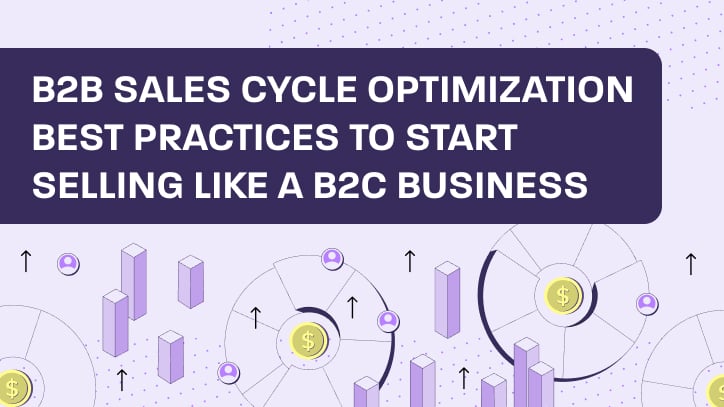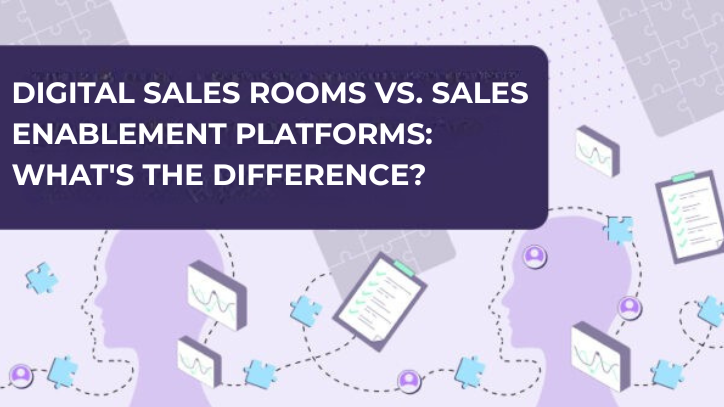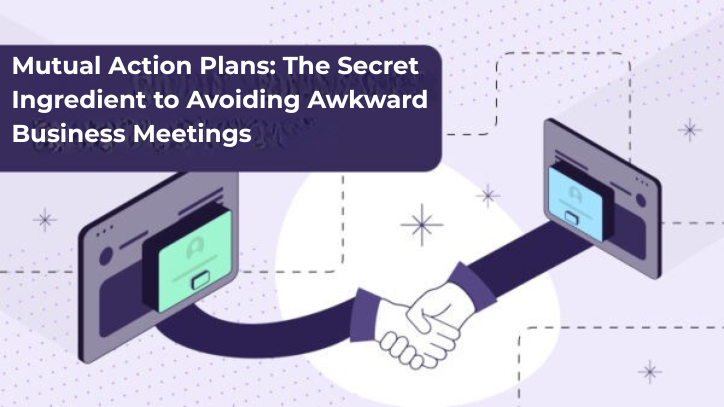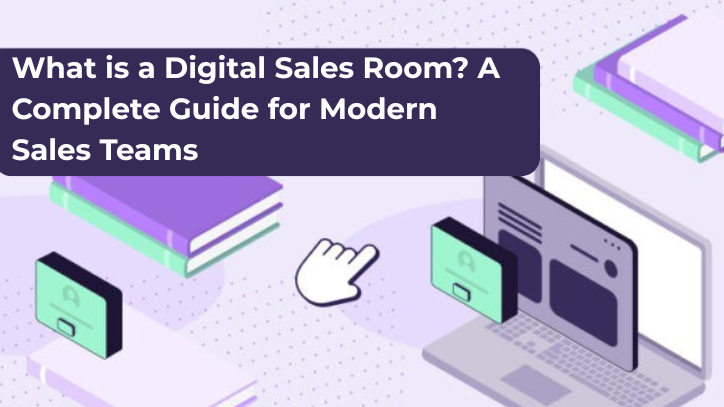It ain’t easy out there for B2B SaaS sellers.
Quotas are too high, sales processes are frustrating, demos are buggy and unreliable, prospects are hard to pin down, and the product roadmap seems to include everything except the exact needs the customers are asking for. Plus, did we mention how high these quotas are?
In all that noise, it can be hard to know what to focus on to improve your sales cycle, boost your sales velocity, and grow your bottom line.
So, that’s what we’ll try to help you with in this article. We’ll break down some of our best advice for how to make things better for sales teams like yours.
What is a B2B sales cycle?
A B2B sales cycle is the process and span in which a business sells its product or service to another business. It refers to the cycle the prospects go through as they move through your sales funnel to become paying customers.
The B2B sales cycle consists of multiple steps, generally starting from the moment prospects connect with the sales team and view a product demo until the deal is closed won and the new customer signs the contract.
Each business defines its B2B sales cycle a little differently. They do this so it can be tweaked and modified to help focus a business’s sale strategy and keep their sales team on target to sell a product or service to another organization.
What is the average B2B sales cycle length?
We hope you’re sitting down because these numbers are ridiculous.
The average sales cycle often lasts around 2-3 months. This means that from the moment a prospect enters the sales process, it’ll take them around 60-90 days until they can purchase the software and move on with their lives.
For enterprise sales, this can be much longer, with deals taking around 6-9 months to close.
This can be a result of having more decision-makers who need to sign off on the deal and more complex legal red tape to navigate.
Other factors that can affect the sales cycle length include the type of product or service being sold, the industry in which the company operates, and the complexity of the sale.
Now, the real question that you’re probably asking yourself is: Who has time for this?
Compared to the average B2C buying cycle, which can be done and dusted in a matter of seconds, B2B sales cycles are preposterously long. The main reason for this is that businesses are different — they are usually not making an impulse buy like we often do when scrolling through Amazon at 2 am. (Just me?) Instead, decision-makers in a business need to substantiate their buying decisions internally and therefore expect you as a provider to show why your offering is the best.
The B2B sales cycle stages
The sales cycle stages are often different for different businesses. For example, some companies believe in showing prospects the product from the outset of the sales cycle (in your prospecting) and focus on the needs of the prospects to make the process as simple as possible.
However, in most sales departments, the sales cycle can be broken down into these 6 stages:
1. Prospecting
At this stage of outbound sales, the sales team (usually SDRs or BDRs) will do some research to find potential customers. They will come up with a list of individuals who match their ideal buyer personas and who can benefit from using their product.
Once they find these prospective buyers, they’ll reach out to them to interest them enough in the product to book a meeting. They can do this through a short cold email, a cold call, or via social media. This part is extremely tricky as they’ll need to stand out from all the other sales outreach they’re already fielding daily. That’s why it is crucial to make sure the outreach is personalized and relevant and shows your product’s value very clearly.
2. Qualifying leads
Once a lead responds to your outreach, the next thing the sales team needs to do is qualify them to make sure they need your product and the ability to purchase it. This is often done through a discovery call.
One of the most common qualifying methods is BANT, which stands for Budget, Authority, Need, and Time – the four main requirements buyers need to have to make a purchase.
3. Presenting the demo
The next step in the sale cycle is presenting the demo.
The goal of this stage is to show your prospects your product and the value they can gain from utilizing it. That’s why it’s beneficial to use a sales demo software that can quickly be customized and personalized for each prospect’s needs, industry, and use case.
This way prospects won’t be stuck watching a demo that doesn’t feel relevant or interesting.
4. Address objections
Once the prospect understands the product’s value proposition, they may have some objections.
Objection handling is a crucial part of the process, where the sales team needs to make sure the prospect truly understands the value of the product, why it is worth the price, how it can solve their pains, why they can trust the brand, and why they need to close the deal now.
5. Closing the sale
Now it’s time to be assertive and handle any legal issues or last-minute customer concerns to push the deal across the finish line.
Sales teams need to make this process as easy and seamless for their prospects to get the deal done!
How to calculate the length of a B2B sales cycle
It can be tricky to get an exact length of your average sales cycle, but knowing everything we already discussed, we can help you get pretty close.
Consider all these stages of the sales cycle and start tracking exactly how long your prospects are spending within each stage. Then analyze the length of time it takes from the prospecting stage until the deal is closed.
Add up all your data, divide it by the number of prospects you tracked, and voila – that’s your average sales cycle length.
8 strategies to shorten your sales cycle:
- Focus on high-quality leads to avoid wasted effort
One of the quickest ways to shorten your sales cycle is by focusing your team’s efforts on high-quality leads. Not all leads are created equal, and pursuing those with a low likelihood of converting can unnecessarily prolong the sales process. Instead, prioritize leads that meet specific criteria aligned with your ideal customer profile (ICP).
Identify your golden leads
To identify high-quality leads, implement a robust lead-scoring system. This system should consider factors such as:
- Website behavior: Are they spending significant time on high-value pages, like product details or pricing?
- Content engagement: Have they downloaded case studies, attended webinars, or engaged with your blog?
- Email interactions: Are they opening and clicking through your emails?
Using this data, assign scores to leads and focus your resources on those who demonstrate strong interest.
For example, a lead who has visited your pricing page multiple times and downloaded a whitepaper could be flagged as sales-ready.
Apply the BANT framework
Additionally, use the BANT (Budget, Authority, Need, Timing) framework to qualify leads:
- Budget: Do they have the financial resources for your solution?
- Authority: Are you speaking with decision-makers?
- Need: Does your product address a clear pain point?
- Timing: Is the prospect ready to buy now?
By filtering leads through this lens, your sales team can focus on prospects who are both interested and capable of purchasing, saving time and energy.
Imagine a SaaS company offering a project management tool. Instead of pitching to every business that downloads a free trial, they focus on those who explore integrations with tools like Slack or Trello—an indicator that the prospect is serious about embedding the solution into their workflow.
By targeting high-potential leads and nurturing them strategically, you can streamline your sales process and close deals faster.
- Train your team to master the sales process
Even the best strategies fall flat if your team isn’t equipped to execute them. Regular training ensures that your sales reps are confident, skilled, and prepared to navigate every stage of the sales cycle effectively.
Audit and refine your process
Start by mapping out your current sales process. Identify bottlenecks where deals often stall and consider streamlining steps.
For example, if approvals from multiple stakeholders slow things down, arm your reps with templates for stakeholder buy-in or prepare them to address common objections.
Focus on continuous learning
Training shouldn’t stop after onboarding. Provide ongoing coaching to refine skills like objection handling, negotiation, and relationship-building. Equip your team with updated product knowledge and insights into industry trends.
Adopt the 3VC model
To keep training effective, regularly measure these key metrics:
- Volume: How many leads enter your pipeline?
- Value: What’s the potential deal size?
- Velocity: How quickly are deals progressing?
- Conversion: How many leads become paying customers?
Realigning these metrics during training sessions helps your team focus on areas where they can improve.
Picture a sales team at a cybersecurity firm. During training, they role-play objection handling for a common scenario: clients worried about data migration. By mastering the art of addressing these fears, they close deals faster and with more confidence.
Empowering your team through consistent, focused training not only shortens the sales cycle but also improves overall performance.
- Address objections proactively to keep momentum
Objections are an inevitable part of the sales process, but addressing them early and effectively can dramatically shorten your sales cycle. Prospects are more likely to move forward if their concerns are resolved before they snowball into deal-breakers.
Anticipate and prepare for common objections
Start by identifying the most common objections your team encounters. These could include pricing concerns, implementation challenges, or hesitations about ROI. Develop clear, persuasive responses for each, and ensure your team is well-versed in delivering them.
For example, if a prospect hesitates about cost, your reps could focus on long-term value: “Our solution reduces downtime by 40%, which saves your team hundreds of hours annually—more than covering the initial investment.”
Ask questions to surface objections early
Encourage your team to ask open-ended questions that reveal potential roadblocks. For example:
- “What concerns do you have about implementing a new solution?”
- “Have you had challenges with similar products in the past?”
By uncovering objections early, you can address them before they delay or derail the sale.
So let’s say a CRM provider notices that prospects frequently express concerns about data migration. To preempt this objection, the sales team creates a detailed implementation guide and shares it during early conversations. This reassures prospects and keeps the deal moving forward.
Proactively tackling objections builds trust and helps prospects feel confident in their decision, speeding up the entire sales process.
- Streamline scheduling to reduce friction
Coordinating meetings between busy sales reps and prospects can be a major time sink, adding unnecessary days or even weeks to the sales cycle. Simplifying this process can make a significant impact.
Leverage scheduling tools
Use tools like Calendly to automate scheduling. These platforms allow prospects to see your availability and book meetings without back-and-forth emails. Not only does this save time, but it also creates a seamless experience for your prospects.
Set clear agendas for every meeting
Once a meeting is scheduled, establish a shared objective upfront. This keeps discussions focused and productive. For instance, if the goal of the meeting is to review a proposal, ensure all decision-makers are present and equipped with the necessary context.
For this, you can imagine that a software company adopts an automated scheduling tool and sees immediate results. Prospects can book demos directly from the company’s website, reducing the time it takes to secure a first meeting from days to hours. By automating follow-up reminders, the sales team ensures that prospects show up prepared and engaged.
Streamlining scheduling is a simple yet powerful way to eliminate unnecessary delays and keep deals moving forward.
Create a robust sales enablement program for your team
A well-organized sales enablement program equips your team with the tools, resources, and training they need to sell more effectively and efficiently.
- Centralize sales resources
Develop a comprehensive library of sales collateral, including case studies, product demos, and competitor comparisons. Ensure that this content is easily accessible so reps can use it in real-time during client interactions.
Provide ongoing coaching
Regular feedback sessions and skill-building workshops keep your team sharp and adaptable.
For instance, train reps to deliver compelling presentations tailored to different stakeholder priorities, such as ROI for CFOs or ease of use for team leads.
Leverage technology
Invest in CRM systems, analytics tools, and automated communication platforms. These tools help reps track leads, manage follow-ups, and identify opportunities for upselling or cross-selling.
For example, let’s say a marketing automation firm creates a sales enablement program focused on interactive product demos. By offering prospects an in-depth, hands-on experience with the software, the sales team reduces the time it takes to close deals by 30%.
A robust sales enablement program is an investment in your team’s success and a key factor in shortening the sales cycle.
- Build trust through social proof
Trust is a cornerstone of any successful sales relationship. By leveraging social proof, you can establish credibility and overcome buyer hesitations more quickly.
Share relevant case studies
Develop case studies that highlight measurable outcomes for clients in similar industries. Focus on how your solution solved specific challenges and delivered ROI.
Showcase testimonials and reviews
Include testimonials from satisfied customers on your website, proposals, and presentations. Hearing from peers helps prospects feel more confident in your product’s value.
Incorporate success metrics
For example, highlight statistics like “95% of our clients see results within 90 days” or “Our solution has reduced onboarding time by 50% for similar companies.”
For instance, in the case of a cybersecurity company—they would want to use social proof to address concerns about compliance. By sharing a case study where a similar client successfully passed a rigorous audit with their solution, they alleviate doubts and fast-track decision-making.
Social proof reassures prospects and accelerates their journey toward a buying decision.
Simplify pricing and contracts for a smoother close
Pricing discussions and contract finalization often create bottlenecks in the sales cycle. By simplifying these processes, you not only build trust with prospects but also accelerate decision-making.
- Be transparent about pricing early on
Many sales reps hesitate to introduce pricing early, fearing it might scare prospects away. However, ambiguity about costs often leads to delays. Address pricing upfront, linking costs to specific benefits.
For example, instead of saying, “We charge a $2,000 onboarding fee,” explain, “This $2,000 onboarding fee covers comprehensive training and a dedicated success manager to ensure you see results within 60 days.”
Transparency not only eliminates surprises but also positions you as a trustworthy partner. Offer tiered pricing options, if applicable, so prospects can align costs with their needs. This flexibility makes it easier for them to commit.
Digitize and streamline contracts
Manual contracts are a relic of the past and can significantly slow down the close. Use tools like DocuSign or Adobe Sign to create digital contracts that prospects can review and sign instantly, from any device. These tools also allow you to track progress and send automated reminders, ensuring no time is wasted.
Simplifying pricing and contracts not only speeds up the process but also enhances the buyer experience, making prospects more confident in their decision.
- Advance the sale with every interaction
Every interaction in your sales cycle should serve a clear purpose: to bring the deal closer to closing. Leaving a call or meeting without a defined next step often leads to stagnation, increasing the risk of losing momentum or focus.
Set clear objectives for every touchpoint
Before engaging with a prospect, determine your goal for that specific interaction.
For instance, if you’re holding a demo, aim to identify additional stakeholders who need to be involved in the decision-making process. After presenting a proposal, set a follow-up meeting to discuss feedback or negotiate terms. Always ensure that both you and the prospect are aligned on the next steps by the end of the interaction.
Tackle objections proactively
Addressing objections early can prevent stalls later.
For example, if you sense hesitation about timelines, ask, “Do you foresee any internal roadblocks that could delay implementation?” By surfacing potential issues, you can create a plan to mitigate them, such as offering phased rollouts or flexible start dates.
Let’s say a marketing agency specializing in paid ads implemented this approach. After every discovery call, the rep emailed a personalized summary, along with action items for the prospect, such as scheduling a strategy session or providing budget details. This not only kept the prospect engaged but also ensured continuous progress toward closing the deal.
Advancing the sale with intentionality ensures no interaction is wasted, keeping the process efficient and aligned with your prospect’s goals.
Best practices for optimizing your B2B sales cycle
At this point, you’re probably asking yourself: why is this sales cycle so long and how can we shorten it?
Well, that’s what we want for you as well.
By optimizing your sales cycle, your sales team can boost their sales velocity and finally make your CRO or VP of sales happy. (Just kidding, it’s impossible to make them happy.)
Here are 6 ways to optimize your sales cycle:
1. Show the product early on
Buyers don’t want to wait until the third call to get a chance to see your product for themselves.
Plus, there’s no better qualifier than a prospect clicking through your product and actively choosing to want to see more.
Embed an interactive product walkthrough on your website and include short demo snippets in your outbound emails. This way, your prospects start your buying journey with a basic understanding of what your product does and how it can help them.
2. Multithread your deals
The more people you speak to within the organization, the quicker you’ll get to the real decision maker and the quicker the value of your product will take hold within the prospects’ team.
Plus, the more people you speak to from the prospects’ side early on, the better you’ll understand their needs, any potential roadblocks, and how to navigate the deal to the finish line.
To improve your multithreading, share a link to your guided product demo with your champion and encourage them to forward it to all the relevant stakeholders.
3. Dive into your buyers’ intent
Understanding buyers is not for the faint of heart. Who can know what really goes on in those confusing, tired minds?
Well, we can help. If you’re using interactive demo software, you can track how your prospects click through your demos, from the product tour on your website to the demo snippets they received from your early sales emails. You can track who they shared your guided demo with on their team and which features they most engaged with.
All of this helps you paint a picture of who they really are and what they really want. And once you know that, give them what they want, what they really really want.
4. Personalize the buying experience
Which brings us to this crucial tip: make the buying decision as simple as possible for your prospect by presenting your product for their specific needs. Stop wasting time demoing features they don’t need just to show off all the cool stuff your product can do. Stop talking to them about stuff that doesn’t relate to their needs and their pains. Because all you’re doing is wasting both your time and theirs.
Instead build a demo library of templates that are designed for specific industries, use cases, or whatever else makes sense for your customer audience. This way you can easily pull out a relevant template and quickly further personalize it for each prospect’s needs.
The result? Less bored prospects and more demos prospects actually want to see.
5. Minimize needless back and forth
Just like many meetings could be emails, many emails could be DMs or 5-second phone calls.
Optimizing the way you communicate with your prospects can significantly shorten the length of your sales cycle. People can take days to respond to emails, even if the answer is really short and simple. By picking up the phone and calling them, you can minimize that unnecessary time spent waiting.
Likewise, if you’re using a sales demo platform, prospects and reps can communicate directly on the demo itself. They can add a comment, tag you, and you can respond immediately.
Likewise, you will get notified every time they open your demo or click through, so you can even preemptively reach out to them while they’re browsing your demo and answer any questions they may have.
6. Simplify the logistics
At the end of the day, the less work your prospect has to do to complete the deal, the easier things are for everyone.
If you need to work closely with legal on a lot of deals, make sure you have a good relationship with the relevant parties and have open communication. Ask them how they prefer to handle any issues that come up so you can move through them swiftly and efficiently.
Same goes for your prospect. Provide them with all the assistance they need to minimize the logistics that they’ll have to do to complete the deal – whether it’s sending them easy-to-sign-and-return PDFs, easy-to-understand terms and agreements, or walking them through the exact steps they’ll need to take to move the deal forward.
The value of efficient sales cycles on SaaS businesses
Time is money.
The shorter your sales process, the lower your customer acquisition cost (CAC) will be. The lower your CAC, the higher your sales efficiency will be. The higher your sales efficiency, the more your sales team will produce. The more your sales team produces, the better your business runs.
Besides, a shorter sales process is better for the buyer as well.
So, here’s what you need to do now. Get started with Walnut and see how we can help your team simplify your sales cycle.





